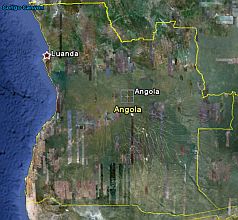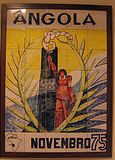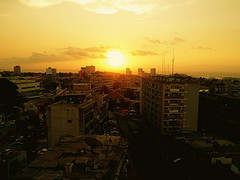
Exploring the history and experiences of mixed heritage persons and inter-racial relationships across the world

Exploring the history and experiences of mixed heritage persons and inter-racial relationships across the world
 Angola apparently has the biggest non-English speaking mixed race community, locally known as Mestizo or Mestiço, in Africa making up some 2% of the estimated 18.5 million people. The term Mestizo was originally used for a people of mixed indigenous American and European ancestry. Despite this small percentage, the Mestizos are visible in Angolan life holding senior positions in politics and in some powerful financial and industrial areas. This has led to some resentment by indigenous groups with accusations of racism and nepotism still evidenced in some sections of Angolan society. This situation has some similarity with the Brazilian experience - though the power base there is regarded as 'white' - and contrasts strongly with the Zimbabwean and South African experience and maybe even with the other ex-Portuguese Southern African colony of Mozambique.
Angola apparently has the biggest non-English speaking mixed race community, locally known as Mestizo or Mestiço, in Africa making up some 2% of the estimated 18.5 million people. The term Mestizo was originally used for a people of mixed indigenous American and European ancestry. Despite this small percentage, the Mestizos are visible in Angolan life holding senior positions in politics and in some powerful financial and industrial areas. This has led to some resentment by indigenous groups with accusations of racism and nepotism still evidenced in some sections of Angolan society. This situation has some similarity with the Brazilian experience - though the power base there is regarded as 'white' - and contrasts strongly with the Zimbabwean and South African experience and maybe even with the other ex-Portuguese Southern African colony of Mozambique.
Like many other African countries, Angola does not have a single ethnic African group - it has 3 major ethnic groups of Bantu origin, the Ovimbundu , the Mbundu and the Bakongo with at least another 5 minorities groups making up some 22% of the population. The colonialists, especially in the scramble for Africa, were not too fussed about keeping the borders in line with the tribal divisions resulting in many aboriginal African groups being divided between two or even more countries.
 Angola was a Portuguese settler colony up to 1975 when it got independence after a liberation war and a coup d'état (government overthrow) in Portugal known as the Carnation Revolution which caused a lot of political upheaval at the time. That was followed almost immediately by a civil war in which thousands died and only ended in 2002.
Angola was a Portuguese settler colony up to 1975 when it got independence after a liberation war and a coup d'état (government overthrow) in Portugal known as the Carnation Revolution which caused a lot of political upheaval at the time. That was followed almost immediately by a civil war in which thousands died and only ended in 2002.
Like many Portuguese colonies, miscegenation, i.e. racial mixing, was actively encouraged during the earlier periods of colonisation. The mixed population of Angola is said to have surpassed the European population in the 1900s when most Europeans in the country were male. The Mestizo population were mainly Roman Catholic, spoke Portuguese and resided in urban areas making it easier for them to attend schools. This ensured that many obtained the status of 'assimilados', the status of a sort of Portuguese African which meant that after 1951, when Angola was declared a province, they could be registered as Portuguese citizens. Somehow even rural Mestizos, growing up in indigenous African villages, appeared to have been able to easily obtain this status. Not many aboriginal Africans achieved the assimilado status both in Angola and Mozambique.
After the Second World War, Portugal, like many other colonising countries, encouraged European immigration to the colonies. These new immigrants were 'crude' working class and are said to have made racial relations, something that the Portuguese always claimed was cordial in their colonies, much worse. The new immigrants insisted in being protected in jobs that hitherto had been filled by educated local people especially those of mixed heritage and other 'assimilados', usually immigrant educated and 'civilised' Africans from other colonies such as Cape Verde.
The increased racialization of the population led many of the Mestizo population to seek equal status with the whites. Some sources claim that the colonisers tried to further classify social status of the mixed group by further defining mulatto (white/black), mestico (mulatto/white), mestico cabrito (mulatto/mulatto) and mestico cafuso (mulatto/black). It is interesting that it would appear that the community somehow resisted this 'divide and conquer' strategy resulting in the global use of Mestizo for all mixes.
Probably due to the limited success in obtaining equal status and the example of other African countries, the community aligned itself with the demands for independence. Their educated and limited privileged status meant the Mestizos dominated nationalist parties' hierarchy and continued to do so post-independence namely in the the MPLA (People's Movement for the Liberation of Angola - Labour Party). This situation continued into at least the 1980s.
At independence, the Portuguese European population numbered about 750,000 but many fled to other countries many to Portugal which, with the Mozambican immigrants, created over a million Portuguese destitute refugees known in Portugal as the retornados. Many neighbouring African countries namely Zimbabwe and South Africa got their Portuguese related populations at the same time. It is however stated by some sources that quite a number of these immigrants returned to Angola in spite of the civil war. However, the European population was never more than 1% of the population.
Some 50,000 Cuban troops and civilian technical personnel the majority male have been stationed in Angola since the early 1970s. It is expected that some of the newer additions to the Mestizo population will be of mixed African and Cuban descent. The numbers involved is unknown but is likely to show up in later population studies.
 With the formation of the CPLP (Community of Portuguese Language Countries) in 1996 there has been an increase of Brazilian immigrants to Angola. Many of these are said to be 'white' Brazilians looking for economic investments in the largely undeveloped country. It is not known how many and whether these immigrants are making Angola their home, it is probably too early to tell whether any mixing will occur. Many Angolans have immigrated to Brazil and it may be that a group of mixed Angolan/Brazilian populations may arise in both countries.
With the formation of the CPLP (Community of Portuguese Language Countries) in 1996 there has been an increase of Brazilian immigrants to Angola. Many of these are said to be 'white' Brazilians looking for economic investments in the largely undeveloped country. It is not known how many and whether these immigrants are making Angola their home, it is probably too early to tell whether any mixing will occur. Many Angolans have immigrated to Brazil and it may be that a group of mixed Angolan/Brazilian populations may arise in both countries.
In line with other African countries, the Chinese presence in Angola is increasing with the increasing investment. The Chinese immigrants are male dominated and it is very likely that new Chinese/African and Chinese/Mestizo mixes will make an appearance in the demographics.
Of particular interest is that the number of Portuguese immigrants in Angola has quadrupled over the past several years causing a reversal in migration flows between Portugal and Angola. Legally, there almost three times the population of Portuguese living in Angola than Angolans in Portugal. Official figures of Angolans in Portugal may differ but in 2004, there were about 20,000 Portuguese in Angola. Today, the Portuguese community is said to be approaching 100,000 and the trend is continuing as Angola experiences an economic boom. If history is to teach us something, some racial mixing will occur with a new generation of original Mestizos coming into existence.
Angola may be one of the few countries outside Europe without a mixed community that comprises a large proportion of the population where the mixed community will have the opportunity to grow in the next few years. That makes it a country worth studying.
Of Interest - Some in Portuguese